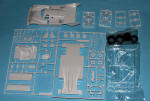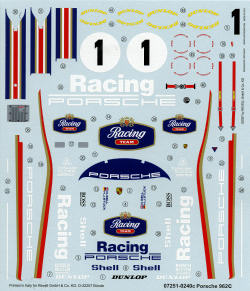
Hasegawa 1/24 Porsche 962C
| KIT: | Hasegawa 1/24 Porsche 962C |
| KIT #: | 07251 |
| PRICE: | $25.90 at GreatModels |
| DECALS: | One option |
| REVIEWER: | Scott Van Aken |
| NOTES: | Curbside, reboxed Hasegawa (?) kit |

| HISTORY |
The Porsche 956 was developed in late 1981, the
intention of Porsche was to run the car in both the World Sportscar Championship
and the North American IMSA GTP Championship. However IMSA GTP regulations
differed from Group C and subsequently the 956 was banned from participating in
IMSA events.
The newer Andial built 3.2L fuel injected Flat-6
would be placed in the 962 by the middle of 1985 for IMSA GT, which made the car
more competitive against Jaguar. However it would not be until 1986 that the
2.6L unit from the 956 was replaced in the World Sportscar Championship, using
2.8L, 3.0L, and 3.2L variants with dual turbochargers. The cars run under World
Sportscar Championship regulations were designated as 962C to separate them from
their IMSA GTP counterparts.. The 3.2L unit, which had been eligible under
IMSA's Group 3 engine rules was banned in IMSA by 1987. In 1988, to counteract
against the factory Nissans
and the threat of withdrawal from Porsche teams, watercooled twin turbo Porsche
engines would be allowed back but with 36 mm restrictors.
Due to the sheer numbers of 962s, some teams took it
upon themselves to adapt the car to better suit their needs or to remain more
competitive against the competition. These modifications included new bodywork
for better aerodynamic efficiency, while others changed mechanical elements.
Long-time Porsche campaigner Joest Racing heavily modified a pair of 962s for
the IMSA GTP Championship in 1993 to better compete against Jaguar, taking the
962s final sprint race victory (Road America) that season.
Among the most popular privately-built 962s was that
from Kremer Racing, termed the 962CK6. 11 total were built, campaigned by Kremer
and other teams. John Thompson designed a chassis for Brun Motorsport, eight of
which were built and helped the team take second in the World Sportscar
Championship in 1987. Thompson would later build two chassis for Obermaier
Racing. Richard Lloyd Racing's GTI Engineering
would turn to Peter Stevens and Nigel Stroud to develop four 962C GTis, which
featured entirely revised aero. Former factory Porsche driver
Vern Schuppan would also build five new
chassis, some known as TS962s.
In the
| THE KIT |
 This
particular kit is a curbside, meaning it has no engine. I also think it is a
Hasegawa kit as all the sprues were packed in a single polybag. Tamiya's kit,
though similar to this, would have had separate sprues and Revell AG has a deal
where it reboxes Hasegawa kits. The Made in Japan label on the side of the box
indicates it must be one of the two.
This
particular kit is a curbside, meaning it has no engine. I also think it is a
Hasegawa kit as all the sprues were packed in a single polybag. Tamiya's kit,
though similar to this, would have had separate sprues and Revell AG has a deal
where it reboxes Hasegawa kits. The Made in Japan label on the side of the box
indicates it must be one of the two.
The interior is nicely done
with decals for the harness and the tach. The raised instrument detail allows
for additional highlighting if you so wish. Wheels are white plastic with rubber
or vinyl tires. The detailing on all the parts is quite good. The one-piece
upper body is well molded and free of any defects, at least none that were
readily apparent. Ejector pin marks on the various bits are mostly hidden once
the car is built that those that are not will be easy to fix.
There are a number of parts on the sprues that are not used for this particular car. Not surprising as racing cars were rarely the same from race to race. The simplicity of this one means that you will be able to build it at a leisurely pace with few worries about fussy bits.
Instructions are well done and provide clear construction steps with Revell paint references. Fortunately, only the turn signal orange needs to be mixed. Decals provide most of the markings needed. The dark blue will have to be painted and it appears to be a dark sea blue. A few decals have this shade and that is what needs to be matched. The markings for the car are for the Monza 1000 km race in 1986 that was won by Hans Stuck and Derek Bell. This same car won Le Mans with these two drivers plus Al Holbert. The markings are for the Rothman's Porsche, however, since I guess model companies can't include tobacco or alcohol sponsors, this one has substituted 'Racing' for Rothmans. This to me is a bit silly, like the swastika paranoia of some countries. Fortunately, there are aftermarket decals to replace these bogus markings. The kit decals are superbly printed in Italy and those you use should work without any problems.
| CONCLUSIONS |
It really is a fine kit whose low parts count should mean a relatively quick build. Painting is rather straightforward and thanks to the white plastic, should mean a minimum of coverage trouble. Having the Revell boxing means a decent savings over the Japanese boxing, though any saving accrued will disappear if one gets the proper markings for it.
| REFERENCES |
http://en.wikipedia.org
May 2008
You can get this and other fine kits and
accessories at
www.greatmodels.com If you would like your product reviewed fairly and quickly, please
contact
me
or see other details in the
Note to
Contributors.